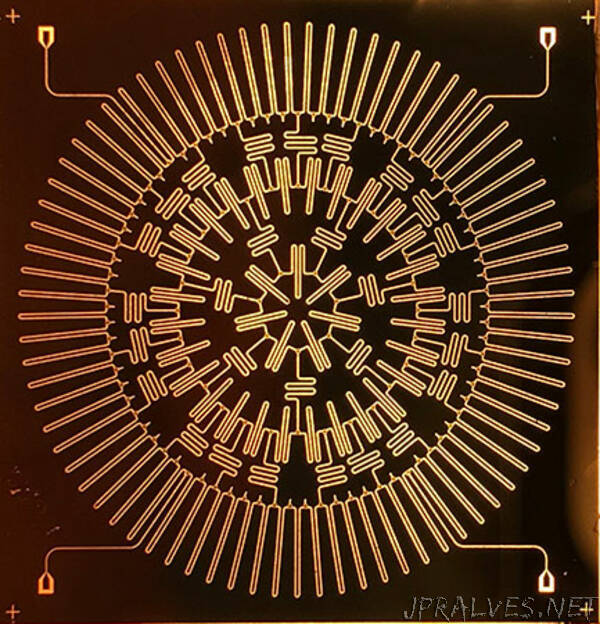
“A U.S. Army project exploring novel applications of superconducting resonators has discovered these systems may be used to simulate quantum materials impossible to otherwise fabricate. Additionally, they may provide insights to open and fundamental questions in quantum mechanics and gravity.
Scientists at Princeton University, led by electrical engineering Professor Andrew Houck, built an electronic array on a microchip that simulates particle interactions in a hyperbolic plane, a geometric surface in which space curves away from itself at every point.
“This research may advance quantum simulation in a way that enables us to not only develop a better understanding of materials relevant to Army goals, but also help us explore questions at the forefront of other fields of Army relevance,” said Dr. Sara Gamble, a program manager with the Army Research Office, an element of the U.S. Army Combat Capabilities Development Command’s Army Research Laboratory. “In addition to the potential materials applications, the fantastic results obtained by the research team can provide insight into communication networks and ultimately enable the DOD to develop more efficient networking capabilities.”
The research, published in Nature, used superconducting circuits to create a lattice that functions as a hyperbolic space. When the researchers introduce photons into the lattice, they can answer a wide range of difficult questions by observing the photons’ interactions in simulated hyperbolic space.
“The problem is that if you want to study a very complicated quantum mechanical material, then computer modeling is very difficult,” said Dr. Alicia Kollár, a postdoctoral research associate at the Princeton Center for Complex Materials. “We’re trying to implement a model at the hardware level so that nature does the hard part of the computation for you.”
The centimeter-sized chip is etched with a circuit of superconducting resonators that provide paths for microwave photons to move and interact. The resonators on the chip are arranged in a lattice pattern of heptagons, or seven-sided polygons. The structure exists on a flat plane, but simulates the unusual geometry of a hyperbolic plane.
“In normal 3-D space, a hyperbolic surface doesn’t exist,” said Princeton electrical engineering Prof. Andrew Houck. “This material allows us to start to think about mixing quantum mechanics and curved space in a lab setting.”
Trying to force a three-dimensional sphere onto a two-dimensional plane reveals that space on a spherical plane is smaller than on a flat plane. This is why the shapes of countries appear stretched out when drawn on a flat map of the spherical Earth. In contrast, a hyperbolic plane would need to be compressed in order to fit onto a flat plane.
To simulate the effect of compressing hyperbolic space onto a flat surface, the researchers used a special type of resonator called a coplanar waveguide resonator. When microwave photons pass through this resonator, they behave in the same way whether their path is straight or meandering. The meandering structure of the resonators offers flexibility to “squish and scrunch” the sides of the heptagons to create a flat tiling pattern, said Kollár, who is starting a faculty position at the University of Maryland and Joint Quantum Institute.
Looking at the chip’s central heptagon is akin to looking through a fisheye camera lens, in which objects at the edge of the field of view appear smaller than in the center — the heptagons look smaller the farther they are from the center. This arrangement allows microwave photons that move through the resonator circuit to behave like particles in a hyperbolic space.
The chip’s ability to simulate curved space could enable new investigations in quantum mechanics, including properties of energy and matter in the warped space-time around black holes. The material could also be useful for understanding complex webs of relationships in mathematical graph theory and communication networks. Kollár noted that this research could eventually aid the design of new materials.
But first, she and her colleagues will need to further develop the photonic material, both by continuing to examine its mathematical basis and by introducing elements that enable photons in the circuit to interact.
“By themselves, microwave photons don’t interact with each other — they pass right through,” Kollár said. Most applications of the material would require “doing something to make it so that they can tell there’s another photon there.”
“The research team is forming connections with researchers in other disciplines because of these results, and the addition of photon interactions into the systems will increase the application space for advancing Army capabilities even further,” Gamble said.”
